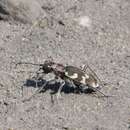Biology
provided by Arkive
Adults breed during spring and summer, and the larvae occur later on in the year inside burrows in the sand. Either pupae or adults hibernate through the winter, and the adults emerge the following spring in order to breed, completing the annual life cycle (3). Adults feed on insects; they are fast runners and fly well, chasing their prey (3).
Conservation
provided by Arkive
Many sites supporting populations of this scarce tiger beetle are designated Sites of Special Scientific Interest (SSSIs) or National Nature Reserves (NNRs); the species therefore benefits from a degree of protection in such areas (3). This beetle has been identified as a priority species under the UK Biodiversity Action Plan (UK BAP). The Species Action Plan produced as a result of this prioritisation aims to maintain the current range of the dune tiger beetle (3). Furthermore, English Nature has included it in its Species Recovery Programme.
Description
provided by Arkive
The dune tiger beetle was once thought to be a subspecies of the very similar species Cincindela hybrida, but is now recognised as a species in its own right (2). Like most tiger beetles, the dune tiger beetle is predatory, and has large jaws. It is generally reddish-brown in colour with blotchy yellowish markings (4).
Habitat
provided by Arkive
As the common name suggests, this beetle inhabits dunes, as well as sandy beaches, where it can be found along the driftline and in the inter-tidal area (5).
Range
provided by Arkive
This coastal species is currently found on both sides of the Bristol Channel, northwest Wales, Norfolk and Kent (3). Historical records are from Lincolnshire, Cornwall and Hampshire (3). It is widespread in Europe, where it is not tied to the coastline (3).
Status
provided by Arkive
Classified as Nationally Scarce in Great Britain (3).
Threats
provided by Arkive
Coastal development, disturbance by recreational use of beach habitats by humans, and the erosion of sand dunes are factors that threaten the survival of this tiger beetle (3). Holiday and urban development is a particular threat (5).

